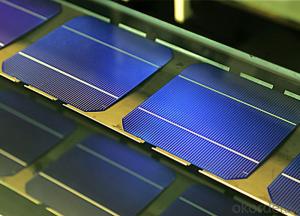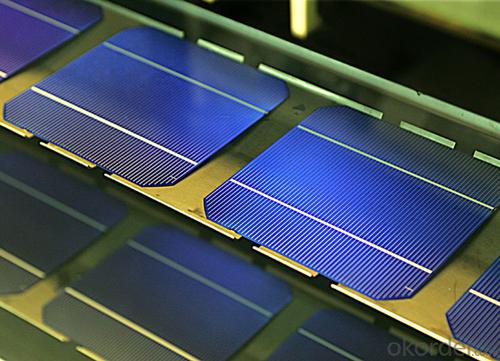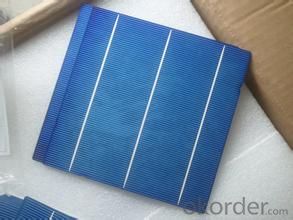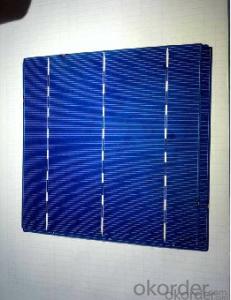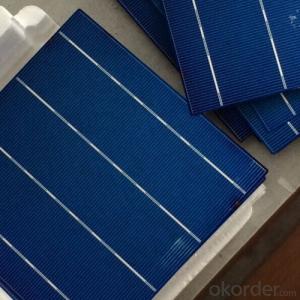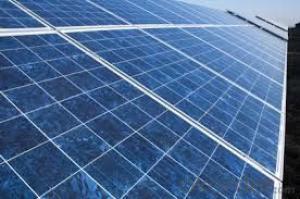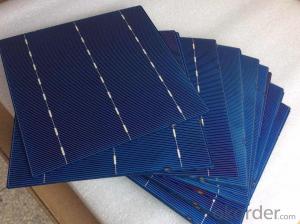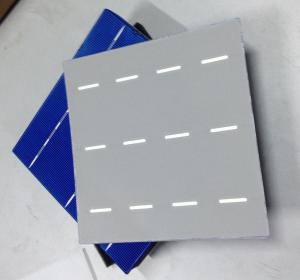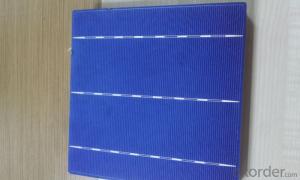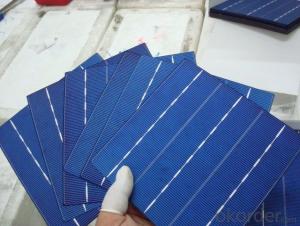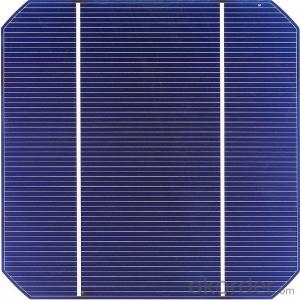Graphene Based Polycrystalline Solar Cells - Tire 1 Manufacturer in China - 17.00%
- Loading Port:
- Shanghai
- Payment Terms:
- TT OR LC
- Min Order Qty:
- 10000 watt
- Supply Capability:
- 500000 watt/month
OKorder Service Pledge
OKorder Financial Service
You Might Also Like
Brief Introduction of Solar Cells
A solar cell, is an electrical device that converts the energy of light directly into electricity by the photovoltaic effect, which is a physical and chemical phenomenon. It is a form of photoelectric cell, defined as a device whose electrical characteristics, such as current, voltage, or resistance, vary when exposed to light. Solar cells are the building blocks of photovoltaic modules, otherwise known as solar panels.
Specifications of Polycrystalline Solar Cells
Format : 156 mm × 156 mm ± 0.5 mm
Thickness: 210 μm ±40 μm
Front (-) : 1.5mm bus bars (silver),blue anti-reflection coating (silicon nitride)
Back (+) : 2.5mm wide soldering pads (silver) back surface field (aluminium)
Efficiency (%) | Pmpp (W) | Umpp (V) | Impp (A) | Voc (V) | Isc (A) |
18.00% | 4.38 | 0.528 | 8.291 | 0.631 | 8.869 |
17.80% | 4.33 | 0.525 | 8.252 | 0.629 | 8.821 |
17.60% | 4.29 | 0.532 | 8.053 | 0.633 | 8.541 |
17.40% | 4.23 | 0.528 | 8.092 | 0.624 | 8.632 |
17.20% | 4.19 | 0.524 | 7.992 | 0.62 | 8.458 |
17.00% | 4.14 | 0.52 | 7.972 | 0.623 | 8.5 |
Advantage of Polycrystalline Solar Cells
1. Tire-1 Solar Cells’ Manufacturer Quality Guarantee. With a complete and sophisticated quality government system, our Quality Management have arrived world’s leading place. Customer can receive Tire-1 Cells Maker’s Quality Standard Products.
2. Trusted Warranty. We can supply trusted after-sales service to our customer. If our cells are found not in conformity to the specification of manufacturer, or should the inspected quantity found in shortage, or should the packing found damaged, the buyer has the right to claim to the seller. The claim, if any, should be presented to seller within 30 days after cargo's arrival date to the port, together with related inspection report and photos issued and provided by a reputable independent surveyor such as SGS.
3. World’s Leading Manufacturer Equipment. We imported the newest and leading production equipment from abroad. Advanced equipment can guarantee the stable quality of cells. Auto production line can also save labor cost which will further cut our production cost.
4. Bulk supply: With the production capacity of 500MW, we can produce large quantity every month. This can satisfy most customer requirement.
Usage of Polycrystalline Solar Cells
Solar cells are often electrically connected and encapsulated as a module. Photovoltaic modules often have a sheet of glass on the front (sun up) side, allowing light to pass while protecting the semiconductor wafers from abrasion and impact due to wind-driven debris, rain, hail, etc. Solar cells are also usually connected in series in modules, creating an additive voltage. Connecting cells in parallel will yield a higher current; our solar cells have passed IEC Certification. With high and stable quality, our cells can greatly improve the performance of Solar Modules.
Applications of Polycrystalline Solar Cells
Assemblies of photovoltaic cells are used to make solar modules which generate electrical power from sunlight, as distinguished from a "solar module" or "solar panel". A solar array generates solar power using solar energy.
Packaging & Delivery of Polycrystalline Solar Cells
Carton Box Package and Deliver by air. It should be noticed that it should be avoid of water, sunshine and moist.
Factory Picture of Solar Cells
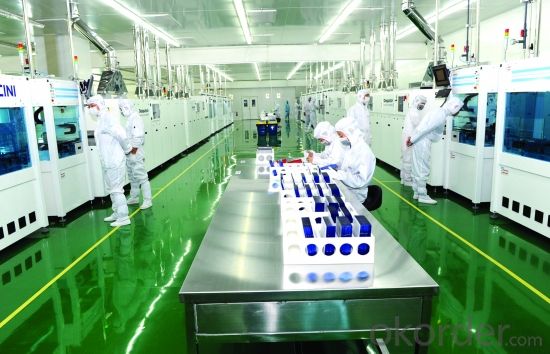
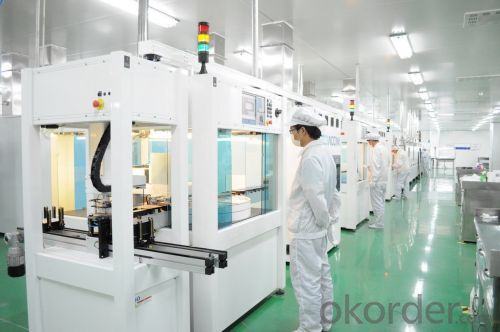
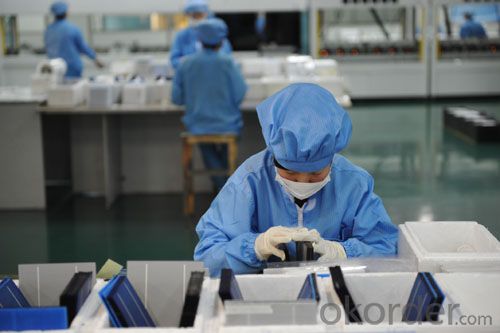
We have organized several common questions for our clients,may help you sincerely:
1. What’s price per watt?
A: It’s depends on the quantity, delivery date and payment terms of the order. We can talk further about the detail price issue. Our products is high quality with lower price level.
2. Can you tell me the parameter of your solar cells?
We have different series of cells with different power output, both from c-si to a-si. Please take our specification sheet for your reference.
3. How do you pack your products?
We have rich experience on how to pack the panels to make sure the safety on shipment when it arrives at the destination.
4. Can you do OEM for us?
Yes, we can.
5. How long can we receive the product after purchase?
In the purchase of product within three working days, We will arrange the factory delivery as soon as possible. The perfect time of receiving is related to the state and position of customers. Commonly 7 to 10 working days can be served.
- Q: Can solar cells be used in remote or inaccessible locations?
- Yes, solar cells can be used in remote or inaccessible locations. Solar panels can be installed in such areas to generate electricity from sunlight, eliminating the need for a traditional power grid connection. This makes solar energy a viable and sustainable option for providing electricity to places that are difficult to reach or far away from existing infrastructure.
- Q: How does the solar cell work in terms of photochemical conversion?
- Photovoltaic power generation principle is the photoelectric transformation, we all know, the semiconductor is between the insulator and the conductor, with a certain conductive properties of the material.
- Q: Do you believe you can make a solar cell by using kitchenware?
- No, I don't believe it at all.
- Q: Is the polymer solar cell the cheapest type among all the different kinds of solar cells?
- Compared to the other solar cell made of the expensive silicon, polymer solar cells are cheaper.
- Q: Are solar cells recyclable?
- Yes, solar cells are recyclable. The majority of their components, such as silicon, glass, and aluminum, can be recycled and reused to manufacture new solar panels. This helps reduce waste and minimize the environmental impact of solar cell disposal.
- Q: What are the different sizes of solar cells?
- Solar cells come in various sizes, ranging from small ones typically used in calculators and devices, to larger ones used in residential and commercial applications. The sizes of solar cells can vary depending on the specific purpose and power output required.
- Q: Can solar cells be used for powering military bases?
- Yes, solar cells can be effectively used for powering military bases. The deployment of solar photovoltaic (PV) systems can provide a reliable and renewable source of energy to meet the electricity demands of military bases. Solar panels can be installed on rooftops, parking structures, or open land, and can generate electricity even in remote locations. Solar power reduces reliance on fossil fuels, increases energy security, and minimizes the environmental impact of military operations. Additionally, solar energy systems can be integrated with energy storage solutions to ensure a continuous power supply, making them a viable option for powering military bases.
- Q: Can solar cells be used for large-scale power generation?
- Yes, solar cells can certainly be used for large-scale power generation. They have the potential to harness abundant sunlight and convert it into electricity on a massive scale. As technology and efficiency of solar cells continue to improve, they are increasingly being deployed in utility-scale solar farms, providing a sustainable and renewable source of power to meet the growing energy demands of our society.
- Q: What are the safety considerations for installing solar cells?
- Some safety considerations for installing solar cells include proper handling and installation to prevent accidents or injuries, ensuring that the electrical connections are done by qualified professionals to avoid electrical hazards, and following proper procedures for working at heights to prevent falls. Additionally, it is important to consider fire safety measures and protection against potential weather-related hazards such as lightning strikes or high winds.
- Q: How much energy can a solar cell produce?
- The amount of energy a solar cell can produce depends on various factors such as the size and efficiency of the cell, the intensity and duration of sunlight, and any potential shading or obstructions. On average, a standard solar cell can generate around 10-20% of the sunlight it receives into usable electricity. However, advancements in technology continue to improve the efficiency of solar cells, pushing the boundaries of energy production higher.
Send your message to us
Graphene Based Polycrystalline Solar Cells - Tire 1 Manufacturer in China - 17.00%
- Loading Port:
- Shanghai
- Payment Terms:
- TT OR LC
- Min Order Qty:
- 10000 watt
- Supply Capability:
- 500000 watt/month
OKorder Service Pledge
OKorder Financial Service
Similar products
Hot products
Hot Searches
Related keywords
